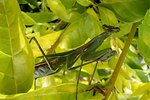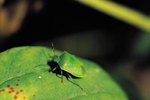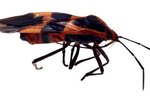Giant leopard moths (Hypercompe scribonia) live throughout the southern and eastern United States, from the northeastern states to Mexico. Giant leopard moths have adapted in ways that help them defend against the various hazards in their environment, including predators and, notably, freezing temperatures.
Frightening Appearance
A primary adaptation for survival for giant leopard moths is their stark colors and markings, which are aposematic -- meaning they warn predators that the insect may be poisonous. They have black spots and rings that contrast their white wings and bright-orange-and-blue-colored abdomens, which are visible when the moths wings are up for flight. As caterpillars, meanwhile, giant leopard moths have black hairs and bright red rings that combine with their spiny textures to intimidate predators.
Withstand Freezing Temperatures
Giant leopard moth caterpillars have the ability to withstand cold temperatures, even to the point of becoming frozen. Researchers Jack Layne and Christine Leszczynski observed in their study "Cold Hardiness and Postfreeze Metabolism in Caterpillars of Hypercompe Scribonia," published in Environmental Entomology, that a third of leopard moth caterpillars studied survived being frozen for two days at 26 degrees Fahrenheit, when 45 percent of their body fluid turned to ice. They gave the caterpillars time to adjust for cold conditions by keeping them at 38 degrees Fahrenheit for four weeks prior to freezing them.
Roll Into a Ball
Like many kinds of caterpillars, leopard moth caterpillars can curl up into tight coils when they feel threatened. They roll up when they sense danger, protecting their vulnerable bellies and heads while also exposing their threatening spiny hairs and bright orange rings to warn predators such as mice to back off. While their black bristles are threatening in appearance, they also can be irritating for predators who come into contact with them.
Yellow Liquid Droplets
Giant leopard moths cannot curl up into balls for defense after they've developed from caterpillars into adults. Instead, giant leopard moths, like many other insects of the Arctiidae family, secrete tiny droplets of yellowish liquid when threatened that serve as a chemical defense. Produced in the glands in their thoraxes, the yellow droplets stick to the moths' sides and leave an unpleasant taste in the mouths of predators.
References
Resources
Writer Bio
Brian McCracken lives in Portland, Ore., where he writes on pets and animal wildlife as well as a wide array of other topics, ranging from real estate to personal development.





